AA Battery
One of the regular "What if" questions is what would happen if cheap consumer rechargeable NiMh cells were used to make up an e-bike battery at low cost. Some while ago A to B magazine did just this with 20 cells to make an add-on back-up battery for a Giant Lafree Comfort, which gave up to five extra miles range, albeit at a slightly reduced performance.
But what if a full size battery was made, what if it was used with a much more powerful motor, what would happen when using a standard charger on these? So I concluded it was time to do a range of tests in an eZee battery shell with eZee's most powerful motor to give some answers to those questions, and there are some surprising results.
The first surprise is that a full size 10 Ah battery using AA NiMh cells matched the Li-ion capacity in having 11% more nominal capacity than the standard 9 Ah NiMh battery. The second and even bigger surprise was that it's weight was virtually the same as Li-ion, just 100 grams heavier and a full kilo lighter than the standard NiMh battery. So it's all good news and we should switch to these immediately? Well, not quite, as ever there are downsides, but read on.
But what if a full size battery was made, what if it was used with a much more powerful motor, what would happen when using a standard charger on these? So I concluded it was time to do a range of tests in an eZee battery shell with eZee's most powerful motor to give some answers to those questions, and there are some surprising results.
The first surprise is that a full size 10 Ah battery using AA NiMh cells matched the Li-ion capacity in having 11% more nominal capacity than the standard 9 Ah NiMh battery. The second and even bigger surprise was that it's weight was virtually the same as Li-ion, just 100 grams heavier and a full kilo lighter than the standard NiMh battery. So it's all good news and we should switch to these immediately? Well, not quite, as ever there are downsides, but read on.
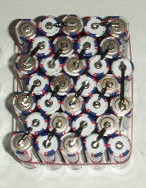
The start point was to create a series wired module which could be used in parallel blocks for different capacities. For the chosen case I made up the interwired module shown at the right, but instead of using 30 cells for the required 36 volts, I used 32 cells in the manner of the Torq Radical's battery to give advance compensation for voltage drop when under load. In all four modules were made using 2500 mAh cells to give the 38.4 nominal volts and a 10 Ah battery. When series of large numbers of cells are connected, it's essential that they are reasonably matched from the same production, and for these I chose the high turnover own brand cells from 7dayshop, £2.99 for a pack of 4, VAT free from the Channel Islands.
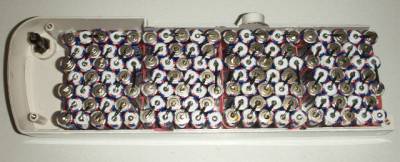
Here you see the four modules in the case before card encasing, probably the only time you'll ever see 128 cells in a bike battery. Those nervous about soldering cells should note that there were 512 iron applications involved, half for tinning and the rest for attachment. I've always tinned these first to minimise thermal shock, and otherwise, the only precaution is to use a hot iron to minimise the contact time. I've been soldering all kinds of cells for years and have never lost one yet.
The modules were enclosed in a made up card shell each time to keep them secure and supported, as seen here on the right.
The modules were enclosed in a made up card shell each time to keep them secure and supported, as seen here on the right.
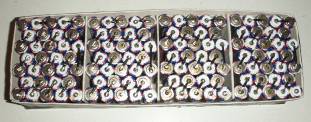
The complete full size battery incorporates Shottky barrier diodes in series with each module to prevent cross transfer of charge between modules, and with charging connections individual to each module made before each diode of course. I didn't want to use a balancing circuit as I wanted to monitor the behaviour of each module separately at all times, so the module charge connections were to a rotary switch and then to the charger socket, so that each module could be charged separately and it's state monitored at the charger socket by switch selection at any time. Thermistor positions were incorporated, one to each module, also wired via the switch so that separate and different thermistor choice experiments could be carried out on each module.
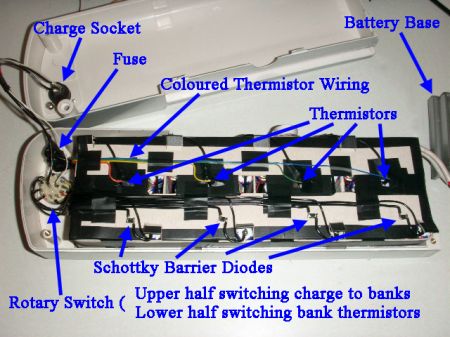
Here's the the completed battery interior at the right with all components identified, total weight of 4.5 kilos, and below the external switch control.
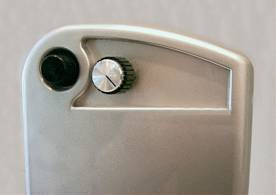
I'll cover the tests in two sections, first the performance results, and second the charging aspects.
In use, the full battery gave slightly reduced power and shorter range that the standard battery, both expected results, since these cells have higher internal resistances due to not being designed for such a high discharge application. The power reduction I'd estimate at around 10%, while the range on my Q bike on the usual test course was just 20 miles, around one third less. However, this should be viewed in the context of the cell cost being just over £90 for 38.4 volts, against a typical D cell cost of a prohibitive £300 for 10 Ah, or £200 for two 8 Ah Powacycle packs to scavenge the cells from those, or best, £170 for a new battery when they become available.
These performance results would be better with a lower powered motor, putting less strain on the cells than the 614 watt gross eZee motor when on 38.4 volts nominal supply.
I also carried out test using one and two modules for reduced capacities. One 2.5 Ah module alone was completely inadequate for this powerful motor so the test was abandonned, the A to B test already having covered this anyway. Using two modules for a 5 Ah backup battery weighing 2.5 kilos was more successful. The power was reduced slightly more, probably losing about 15%, but perfectly adequate as "get home" power, but the range was greatly reduced. Instead of the half capacity halving the range, it quartered it to only just 5 miles, this due to the stresses of the very high motor demand on a high resistance 5 Ah source. This usage also generated high cell temperatures due to stress. Although well below what D cells would give, this again should be viewed in the context of a 2.5 kilo back-up battery using an existing case for about £45 only.
One operating problem was that the different characteristics of the AA cells meant the controller failed to cut-out at at above one volt per cell, making it imperative that usage was terminated as soon as the battery meter was down to continuous red to avoid module thermal runaway.
Charging was problematic. The standard NiMh charger is too energetic for the job of charging the modules, causing a temperature rise much above normal, bringing eratic premature thermistor cut out. This was less of a problem if the modules were coupled and charged in parallel of course. One simple solution was found by using the eZee Li-ion charger, the case in use having been a Li-ion battery previously. This charger is limited to 41.4 volts and is incapable of overcharging these NiMh cells, so thermistors aren't needed, the charger having no connection for them anyway. Using this charger terminates charge as peak voltage is reached, leaving the modules a little undercharged but completely safe.
Obviously using a charge balancing circuit and charging the whole battery in one operation would solve the problems and permit the standard NiMh charger to be used. However, I'd seen enough to know that I wouldn't use these cells as a full battery, so parallel charging using two modules for a 2.5 kilo 5 Ah back up battery was enough. Therefore I've rewired the switch with both modules through one position for charging, but each module through another separate connection so that each can be individually monitored for health at any time.
Having ascertained that I only needed two modules, I did destruction testing on the remaining two to check the safety position. One was wired into place and ridden on continuous battery meter red to low voltage thermal runaway, the other was charged to thermal destruction.
In both cases, very high temperatures were reached, but since the soldered connections melted and dropped away, the whole pack capacity was incapacitated before explosion was possible. Some of the wires dropping away set up new shorts, but these only involved small groups and no cell melted down completely though thermal generation was inclined to continue, so each destroyed module was cooled in a cold water bath.
So there's all the answers, yes, these cells can be used, but they are best for a backup battery only, and best of all in that application for a lower powered electric bike.
In use, the full battery gave slightly reduced power and shorter range that the standard battery, both expected results, since these cells have higher internal resistances due to not being designed for such a high discharge application. The power reduction I'd estimate at around 10%, while the range on my Q bike on the usual test course was just 20 miles, around one third less. However, this should be viewed in the context of the cell cost being just over £90 for 38.4 volts, against a typical D cell cost of a prohibitive £300 for 10 Ah, or £200 for two 8 Ah Powacycle packs to scavenge the cells from those, or best, £170 for a new battery when they become available.
These performance results would be better with a lower powered motor, putting less strain on the cells than the 614 watt gross eZee motor when on 38.4 volts nominal supply.
I also carried out test using one and two modules for reduced capacities. One 2.5 Ah module alone was completely inadequate for this powerful motor so the test was abandonned, the A to B test already having covered this anyway. Using two modules for a 5 Ah backup battery weighing 2.5 kilos was more successful. The power was reduced slightly more, probably losing about 15%, but perfectly adequate as "get home" power, but the range was greatly reduced. Instead of the half capacity halving the range, it quartered it to only just 5 miles, this due to the stresses of the very high motor demand on a high resistance 5 Ah source. This usage also generated high cell temperatures due to stress. Although well below what D cells would give, this again should be viewed in the context of a 2.5 kilo back-up battery using an existing case for about £45 only.
One operating problem was that the different characteristics of the AA cells meant the controller failed to cut-out at at above one volt per cell, making it imperative that usage was terminated as soon as the battery meter was down to continuous red to avoid module thermal runaway.
Charging was problematic. The standard NiMh charger is too energetic for the job of charging the modules, causing a temperature rise much above normal, bringing eratic premature thermistor cut out. This was less of a problem if the modules were coupled and charged in parallel of course. One simple solution was found by using the eZee Li-ion charger, the case in use having been a Li-ion battery previously. This charger is limited to 41.4 volts and is incapable of overcharging these NiMh cells, so thermistors aren't needed, the charger having no connection for them anyway. Using this charger terminates charge as peak voltage is reached, leaving the modules a little undercharged but completely safe.
Obviously using a charge balancing circuit and charging the whole battery in one operation would solve the problems and permit the standard NiMh charger to be used. However, I'd seen enough to know that I wouldn't use these cells as a full battery, so parallel charging using two modules for a 2.5 kilo 5 Ah back up battery was enough. Therefore I've rewired the switch with both modules through one position for charging, but each module through another separate connection so that each can be individually monitored for health at any time.
Having ascertained that I only needed two modules, I did destruction testing on the remaining two to check the safety position. One was wired into place and ridden on continuous battery meter red to low voltage thermal runaway, the other was charged to thermal destruction.
In both cases, very high temperatures were reached, but since the soldered connections melted and dropped away, the whole pack capacity was incapacitated before explosion was possible. Some of the wires dropping away set up new shorts, but these only involved small groups and no cell melted down completely though thermal generation was inclined to continue, so each destroyed module was cooled in a cold water bath.
So there's all the answers, yes, these cells can be used, but they are best for a backup battery only, and best of all in that application for a lower powered electric bike.
18.7.2007
.
.